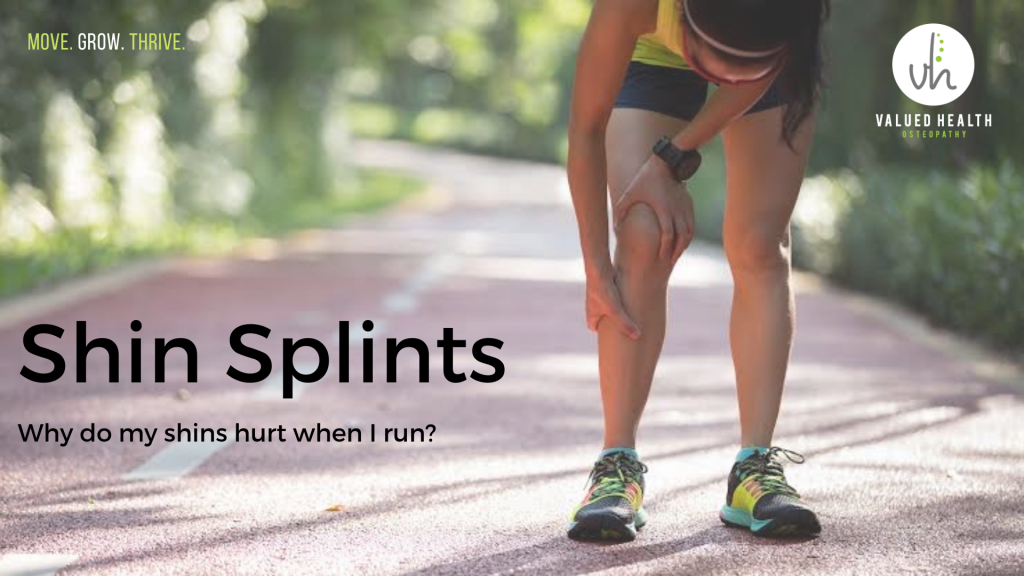Shin Splints
My shins hurt when I run. Is it Shin Splints?
Valued Health Osteopathy
3/658 Centre Rd, Bentleigh East, 3165
Shin pain is a problem that many runners face in their time of running. Pain down the front of the shins is commonly known as shin splints, although this is just an umbrella term used to describe any type of pain around the shins. One of the most common forms of shin splints is a condition more formally known as Medial Tibial Stress Syndrome (MTSS).
MTSS is defined as “exercise-induced pain along the posterior medial tibial border, and recognisable pain is provoked on palpation of the posterior medial border over a length of ≥5 consecutive centimetres” (1).
MTSS is a condition which can cause pain along the front and inside portion of the shin bone and is typically associated with exercise that involves running and/or jumping although. There is still a lack of clarity as to what the actual root pathophysiological cause of MTSS is, as to whether it is a bone overloading injury or a fasciopathy type injury (1). MTSS is a common condition faced by runners with an incidence of 9.4% and prevalence of 9.1% (1).
Shin splints can be caused by many different factors. Some of the most common causes of MTSS are:
From inappropriate running load and volume, and inadequate lower limb muscular strength and endurance. When runners either increase their running volume or their running load/intensity at too great a rate, then the tissues in the lower leg are not given enough time to adapt to the increased workload, putting stress on the tissues. In runners with MTSS, it is common to find muscular strength and endurance imbalances between each leg. On the affected leg, the ankle plantar flexor muscles can be found to have 56% less endurance capacity, Tibialias Anterior can be 20% weaker, the Peroneal muscles can be 17% weaker, Soleus can be 12% weaker and Flexor Hallicus Longus can be 25% weaker than the non-affected leg. There are other factors that are also be considered when evaluating and managing MTSS in addition to load and muscle imbalances (2).
Risk Factors for MTSS
• Increased Body Mass Index (BMI)
• Increased exercise load
• Inappropriate footwear
• Muscular weakness of the foot and leg
• Female
What does MTSS feel like?
MTSS typically presents with soreness and tenderness, particularly to touch, along the front and inside aspect of the shin bone and is most noticeable after running. This can occur for several months and without appropriate treatment and management can get worse over time, which in some cases can lead to tibial stress fractures.
What does management of MTSS look like?
MTSS is condition that can take an extended period of time to fully resolve, with full resolution possibly taking several months. The chance of relapsing is increased if appropriate load management is not appropriate or optimal. Despite the lack of clarity as to whether MTSS is a bone overloading injury or a fasciopathy, load management is effective at managing both pathophysiology’s (1).
Appropriate management involves but is not limited to.
• Addressing muscle weaknesses by applying appropriate muscular strength and endurance training.
• Appropriate load management of running and other exercise.
• Exercise modification.
• Addressing running technique errors.
• Addressing inappropriate running shoes.
Suffering from Shin splints? We may be able to help. Speak to one of our Osteopaths at Valued Health Osteopathy in Bentleigh East about your treatment and rehabilitation options. Call or book online today.
Make an appointment today – Book online!

You do not need a referral to see one of our friendly Osteopaths at Valued Health Osteopathy. We have a very good relationship with many surrounding doctors, other health practitioners and personal trainers in the local community of Bentleigh East , Bentleigh, Ormond, McKinnon, Oakleigh, Carnegie, Caulfield, Moorabbin, Murrumbeena, Brighton, Clayton and Clarinda.
Valued Health Osteopathy is a trusted provider of Osteopathy, Pelvic Health, Infants & Children, Clinical Pilates, Exercise Rehabilitation and Strength & Conditioning. Valued Health Osteopathy is open 6 days a week with early morning and evening appointments.
Valued Health Osteopathy is located at 3/658 Centre Road, Bentleigh East, Melbourne, Victoria, 3165.
Valued Health Osteopathy | Osteopathy Australia
Osteopath Bentleigh East, Osteopath Bentleigh, Osteopath Ormond, Osteopath McKinnon, Osteopath Moorabbin, Osteopath Murrumbeena, Osteopath Oakleigh, Osteopath Carnegie, Osteopath Caulfield, Osteopath Clayton, Osteopath Brighton and Osteopath Cheltenham, Osteopath Dingley, Osteopath Beaumaris, Osteopath Melbourne.
References:
- Winters, M. The diagnosis and management of medial tibial stress syndrome.Unfallchirurg 123 (Suppl 1), 15–19 (2020). https://doi.org/10.1007/s00113-019-0667-z
- Mattock, J., Steele, J.R. & Mickle, K.J. Lower leg muscle structure and function are altered in long-distance runners with medial tibial stress syndrome: a case control study.J Foot Ankle Res 14, 47 (2021). https://doi.org/10.1186/s13047-021-00485-5
- Newman P, Witchalls J, Waddington G, Adams R. Risk factors associated with medial tibial stress syndrome in runners: a systematic review and meta-analysis. Open Access J Sports Med. 2013 Nov 13;4:229-41. doi: 10.2147/OAJSM.S39331.

